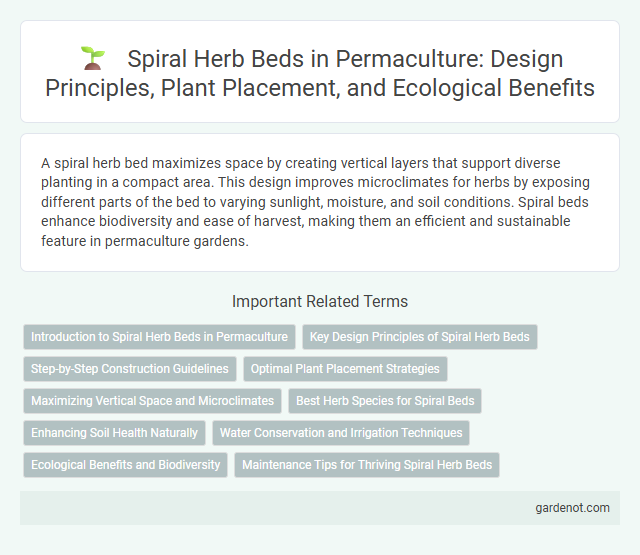A spiral herb bed maximizes space by creating vertical layers that support diverse planting in a compact area. This design improves microclimates for herbs by exposing different parts of the bed to varying sunlight, moisture, and soil conditions. Spiral beds enhance biodiversity and ease of harvest, making them an efficient and sustainable feature in permaculture gardens.
Introduction to Spiral Herb Beds in Permaculture
Spiral herb beds maximize space and create diverse microclimates within a compact design, ideal for permaculture gardens. The structure provides varied moisture, sunlight, and soil conditions, accommodating a wide range of herbs from basil and thyme to rosemary and mint. This efficient vertical design enhances biodiversity and promotes sustainable herb cultivation by mimicking natural ecosystems.
Key Design Principles of Spiral Herb Beds
Spiral herb beds maximize vertical space by arranging plants in a compact, 3D spiral structure that increases biodiversity and microclimates. Key design principles include zoning plants by water needs, placing drought-tolerant herbs like rosemary at the top and moisture-loving ones like basil at the bottom. The design enhances soil drainage, sunlight exposure, and accessibility, promoting efficient resource use and sustainable growth in permaculture gardens.
Step-by-Step Construction Guidelines
Constructing a spiral herb bed starts with selecting a sunny location and marking a circular base approximately 1.5 meters in diameter. Begin by stacking stones or bricks to form a raised spiral wall, gradually increasing height toward the center, creating microclimates for diverse herb growth. Fill the structure with well-draining soil mixtures, layering compost and sand to support moisture retention and root health, then plant herbs according to their sunlight and water needs, positioning tall herbs at the top and moisture-loving ones at the base.
Optimal Plant Placement Strategies
Spiral herb beds maximize space by positioning plants according to their water, sunlight, and soil nutrient needs, creating microclimates that enhance growth. Taller, sun-loving herbs like rosemary are planted at the top, while moisture-loving herbs such as mint thrive near the base where water collects. This strategic placement supports healthy plant development and efficient resource use within the permaculture garden design.
Maximizing Vertical Space and Microclimates
Spiral herb beds maximize vertical space by stacking planting zones in a compact, three-dimensional design that accommodates diverse herbs with varying sunlight and moisture needs. This structure creates multiple microclimates, from dry, sun-exposed tops suitable for Mediterranean herbs to moist, shaded bases ideal for moisture-loving plants. Efficient use of vertical layers enhances biodiversity, promotes healthy plant growth, and optimizes garden yield in limited spaces.
Best Herb Species for Spiral Beds
Spiral herb beds maximize space and microclimates, making them ideal for diverse herb cultivation such as thyme, oregano, and chives which thrive in well-drained, sunny conditions at the top. Mint and basil flourish in the mid-level, where moisture levels are moderate, while coriander and parsley prefer the shadier, more humid base. Choosing these species ensures optimal growth and culinary variety, enhancing both the productivity and sustainability of permaculture gardens.
Enhancing Soil Health Naturally
A spiral herb bed maximizes space and promotes diverse microclimates, encouraging beneficial microbial activity that enhances soil health naturally. The layered structure improves water retention and aeration, fostering nutrient-rich, well-drained soil conditions ideal for robust herb growth. Integrating organic mulches and compost along the spiral further supports soil fertility and sustainable ecosystem balance.
Water Conservation and Irrigation Techniques
A spiral herb bed maximizes water conservation by directing runoff to plant roots while minimizing evaporation through its layered design with soil and mulch. The structure allows gravity-fed drip irrigation or self-watering systems to efficiently hydrate diverse herbs at varying moisture needs. Integrating swales or contour lines around the spiral enhances moisture retention and reduces irrigation frequency in permaculture gardens.
Ecological Benefits and Biodiversity
A spiral herb bed maximizes ecological benefits by creating diverse microhabitats that support a wide range of beneficial insects, pollinators, and soil organisms, enhancing overall garden biodiversity. Its vertical design conserves space while promoting efficient water use and natural nutrient cycling, reducing the need for artificial inputs. This structure also fosters a resilient ecosystem by providing varied light, moisture, and soil conditions conducive to growing multiple herb species harmoniously.
Maintenance Tips for Thriving Spiral Herb Beds
Regularly prune herbs in spiral herb beds to promote healthy growth and prevent overcrowding, ensuring optimal air circulation. Water sparingly, targeting the soil at the base to avoid fungal diseases common in densely planted spirals. Incorporate mulching with organic materials to retain moisture and suppress weeds, enhancing soil fertility and plant vitality.
Spiral herb bed Infographic

 gardenot.com
gardenot.com